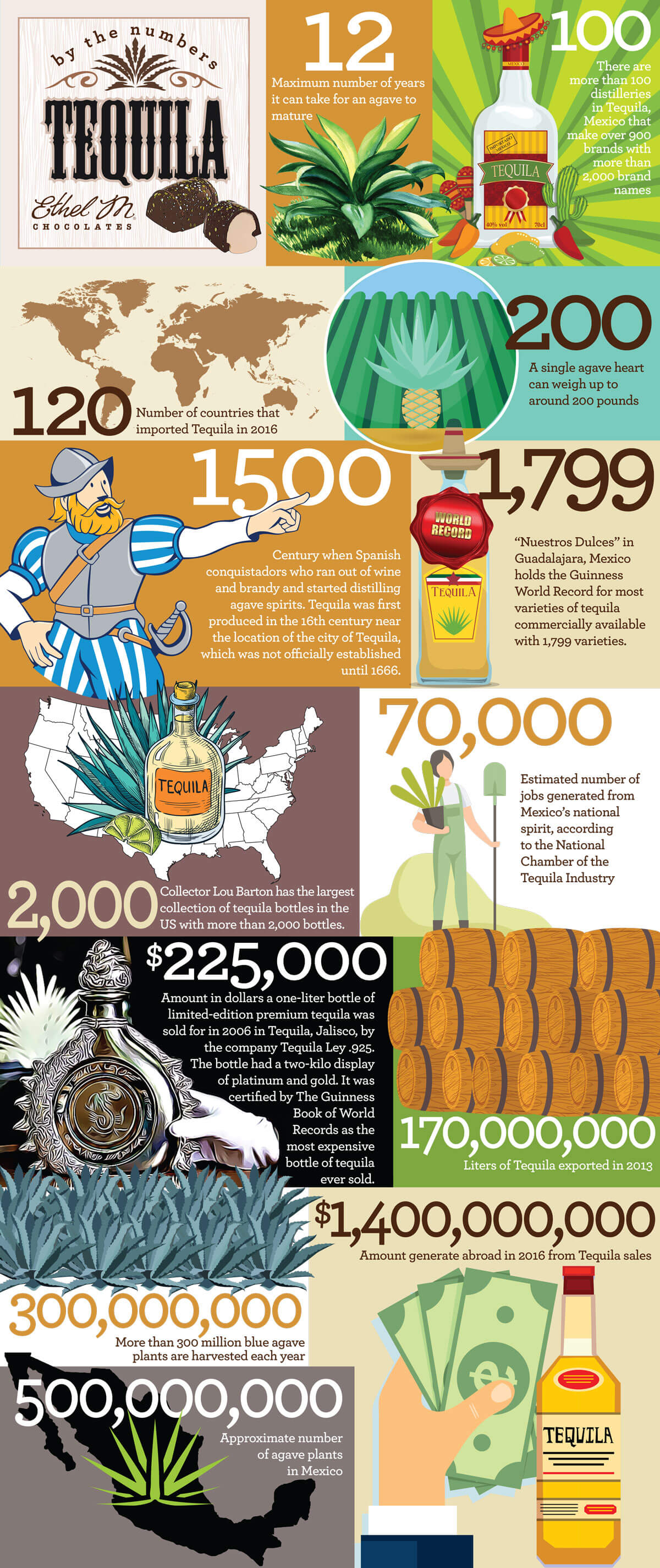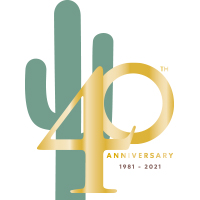All About Tequila

Tequila: A Rich History with Rich Flavor
One of the unique offerings at Ethel M Chocolates is a collection of Crème Liqueurs that combine the signature decadent chocolate with premium spirits. The creamy, masterfully blended centers, such as in the Agave Tequila Crème Liqueur Dark Chocolate, have yielded some creative culinary surprises for a delightfully satisfying flavor combination. Dark Chocolate is paired with Agave Tequila in a crème liqueur center. Much like Ethel M Chocolates and our small-batch creations, making tequila is a carefully curated, time-tested process rich with tradition and pride. Even if the same type of plants and ingredients are used, Mexico has ensured that no imitations or substitutions would be accepted for this chief export in that only tequila FROM the city of Tequila can be named and labeled as such. The word "tequila" originates from the Aztec language Nahuatl Tequillan. Tequila is named after the region of the same name where the spirit originated and blue agave plants used to make it are still harvested today.
The Process of Making Tequila
Though agave cultivation is a painstaking and laborious process, it is also one held in high esteem. The farmers that harvest the plants are referred to as "jimadores." These skilled workers use a special knife called a "coa" that has a circular blade attached to a long pole that removes leaves to access the piña, i.e. the succulent core of the agave plant. Harvesting must be done at the right time or there will not be the proper amount of carbohydrates to ferment into Tequila.
Once harvested, the piñas are baked slowly in an oven as Agave needs to be cooked before it can be fermented (raw agave tastes like an uncooked potato). Then it is shredded or mashed underneath a tahona, which is a large stone wheel used to extract the agave juice. After fermenting for a few days, the result is low-alcohol "wort/mosto." To make tequila, this liquid is distilled a second time as required by law to be classified as the spirit.
The Four Categories of Tequila
Blanco ("white") or Plata ("silver"): White spirit, unaged, and bottled or stored right after distillation, or aged for two months or less in stainless steel or neutral oak barrels.
Reposado ("rested"): Aged for a minimum of two months, but less than a year in any sized oak barrels.
Añejo ("aged" or "vintage"): Aged for a minimum of one year, but less than three years, in small oak barrels.
Extra Añejo ("extra-aged" or "ultra-aged"): Aged for a minimum of three years in oak barrels, a category first introduced in 2006.
Myths and Mysteries About Tequila
As a complicated spirit, there are many myths and misconceptions about tequila, as well as some interesting and unexpected facts. For example:
The agave plant is not a cactus. It actually belongs to the Agavoideae family, which is more closely related to the lily plant.
All tequila is mezcal, but not all mezcal is tequila. Tequila is always double-distilled, while mezcal is generally distilled once.
The tequila worm is a farce. Only certain mezcals are sold "con gusano" (with a worm) and added as a marketing gimmick that started with false claims it possessed magical or aphrodisiac properties. The inclusion of a worm or scorpion is also forbidden by the Tequila Regulatory Council.
Agave plants are pollinated by bats. Agave plants flower at night and are "chiropterophilous," meaning that bats do the work, as opposed to insects or birds.
Tequila drinkers in Mexico sip and savor the drink. Conversely, in the United States, it is more common to take a shot with lime and salt. In Germany and some other countries, tequila oro (gold) is often consumed with cinnamon on a slice of orange after, while tequila blanco (white) is consumed with salt and lime.
Tequila does not change much once bottled. Unlike wine with its tannins that may change with time, tequila is a distilled liquor that doesn’t does have specific storage conditions, similar to whiskey, rum, or vodka.
Diamonds can be made from tequila: Physicists at the National Autonomous University of Mexico discovered a way to make artificial diamonds out of tequila. However, the synthetic diamonds are too small to be used in jewelry making, but can be used for numerous electronic and industrial purposes.
The Four Categories of Tequila
Blanco ("white") or Plata ("silver"): White spirit, unaged, and bottled or stored right after distillation, or aged for two months or less in stainless steel or neutral oak barrels.
Reposado ("rested"): Aged for a minimum of two months, but less than a year in any sized oak barrels.
Añejo ("aged" or "vintage"): Aged for a minimum of one year, but less than three years, in small oak barrels.
Extra Añejo ("extra-aged" or "ultra-aged"): Aged for a minimum of three years in oak barrels, a category first introduced in 2006.
Special Tequila for Celebrations and Holidays
Cinco de Mayo: Interestingly enough, Cinco de Mayo is a bigger deal in the U.S. than Mexico. One misconception is that the fifth of May celebrates Mexican Independence, but that’s not the case. The date actually marks when Mexican forces defeated a French expeditionary force at Puebla in 1862. So why is celebrating Cinco de Mayo more an American tradition? While the battle it commemorates is real, the marketing team at Corona beer actually created the big push to celebrate and imbibe, thus the addition of Mexican Ttequila becoming a staple on that day as well.
National Tequila Day (U.S.): July 24 is the annual unofficial day when Americans celebrate the spirit.
National Tequila Day (Mexico): Now this one is official and recognized by the Mexico Senate. Celebrated annually on the third Saturday in March, the first one surprisingly only took place on March 16, 2019.
Mexican Independence Day: The actual day Mexico celebrates its independence is on September 16. It commemorates the day in 1810 when Priest Miguel Hidalgo y Costilla rallied Mexicans to fight against Spain’s colonial rule and started Mexico’s war for independence. It’s also referred to as the Grito de Dolores, or "Cry of Dolores."
Day of the Dead: AKA El Dia de los Muertos, takes place October 31 to November 2. Though the holiday revolves around the dead, it is a happy and positive time to celebrate life, family, food and drink, to honor the memory of departed loved ones. Originating in Mexico, it is fitting that tequila is a popular offering of respect placed on graves and used for toasting.
Tequila by the Numbers

12: Maximum number of years it can take for an agave to mature
100: There are more than 100 distilleries in Tequila, Mexico that make over 900 brands with more than 2000 brand names
120: Number of countries that imported tequila in 2016
200: A single agave heart can weigh up to around 200 pounds
1500: Century when Spanish conquistadors who ran out of wine and brandy and started distilling agave spirits. Tequila was first produced in the 16th century near the location of the city of Tequila, which was not officially established until 1666.
1799: Nuestros Dulces in Guadalajara, Mexico holds the Guinness World Record for most varieties of tequila commercially available with 1799 varieties.
2000: Collector Lou Barton has the largest collection of tequila bottles in the US with more than 2000 bottles. 70,000: Estimated number of jobs generated from Mexico’s national spirit, according to the National Chamber of the Tequila Industry.
225,000: Amount in dollars a one-liter bottle of limited-edition premium tequila was sold for in 2006 in Tequila, Jalisco, by the company Tequila Ley .925. The bottle had a two-kilo display of platinum and gold. It was certified by The Guinness Book of World Records as the most expensive bottle of tequila ever sold.
300,000,000: More than 300 million blue agave plants are harvested each year
170,000,000: Liters of tequila exported in 2013
500,000,000: Approximate number of agave plants in Mexico
1,400,000,000: Dollar amount generate abroad in 2016 from tequila sales
Making Ethel M Chocolates’ Dark Chocolate Agave Tequila Crème Liqueur
Bean-to-Box Cocoa
As we mentioned, there are numerous similarities between tequila and chocolate-making. For example, our chocolate is "Bean-to-Box," meaning our cocoa is sourced directly from the farmer using "machete technology," much like the jimadores with their coa. The cocoa beans are then roasted to bring out the flavor and color at MARS’ factory in Elizabethtown, PA. Once roasted, the cocoa beans are ground into a liquid called "chocolate liquor." The grinding process separates the cocoa butter from the chocolate liquor (to be added back in later for dark chocolate).
Agave Tequila Filling
The Dark Chocolate Agave Tequila Crème Liqueur filling is produced locally at our solar-powered Ethel M factory in Henderson, NV. The Tequila is sourced from Cazadores Anejo Tequila, which is made from 100% blue agave grown in the Highlands of Jalisco, then aged at least 12 months in new, small, American white oak casks to create extra smooth flavors of oak, plus cinnamon, vanilla, nut, and pear undertones that make it delectable for sipping, as well as pairing with premium chocolate.
Savoring the Complex Flavor Notes
Aromatics: Dark chocolate, roasted espresso, with hints of tequila and vanilla
Flavor: Sweet tequila, comforting toasty glass of milk before bed, roasted cocoa, fresh-brewed coffee, premium dark chocolate
Texture/Surface: Smooth and creamy, with a mouth-warming finish. Each piece is hand-sprayed with a colorful contrast that harkens back to Ethel M Chocolates’ famed Cactus Garden with hints of the desert blooming in springtime.
Want to sample the Ethel M Chocolates’ Dark Chocolate Agave Tequila Crème Liqueur? Stop by our factory in Henderson, NV, just a short distance from the famed Las Vegas Strip. Tour our factory for free and check out the Ethel M Chocolates Botanical Cactus Garden. Tasting classes and wine pairing experiences are also available, plus our team of experts can help you plan special events as well. Sign up for our mailing list for exclusive discounts and details about special events, like our holiday light display and spring spectacular.


